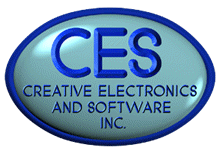

Creative Electronics and Software, Inc.
CES is the most recent manufacturer of wall games, producing games similar to Gremlin games.
CES presently manufactures test fixtures and ticket-dispensing children's games, as well as a multi-game cocktail-format video game system. Their wall games are no longer in production.
September 30, 2004 update - I was attending an SCO Unix Seminar in Chicago, and decided to drive over to the CES plant in South Elgin, IL. I had printed out the driving directions from maps.yahoo.com the night before, and expected the drive to take a half hour. Heavy traffic meant that it actually took an hour and fifteen minutes, and since the time was now 4:45 PM, I was afraid they would be closed. Fortunately for me, the office hours were until 5:00 PM.
Although I was an unexpected visitor, the receptionist had one of the Software Engineers, Justin Love, come down to speak with me. We went into a conference room, where I asked questions about the company, it's former line of wall games, and what the company is doing now.
Justin had not been with the company back when the wall games were produced, but had seen some of the components sitting around in an upstairs room. I asked if I could see them, and he obligingly took me upstairs. The hallway leading to the upstairs storage room was lined with windows on the left side, allowing me to look down at the factory operating below. According to Justin, their primary business was manufacturing printed circuit boards for other companies, including Stern Pinball Inc.
I was able to look closely at one of their Country Club Classic wall games. The game was being stored on the floor between a couple of other game parts (part of a multiplayer gun game and what appeared to be toppers to a ticket redemption game). There were no remote controls or coin boxes, just the display panel which hangs on the wall.
We pulled the game out, and the first thing that caught my attention was the power supply, which was positioned in the upper right hand corner of the game. It was an AT computer power supply, and the power cord was a detachable "business equipment/computer"-style cord, typical for computer power supplies.
We released a latch in the middle of the bottom of the game, and the display panel lifted up. Interestingly, it was supported on each side by gas-charged shock absorbers, similar to those used on automobile hatchbacks.
For those of you familiar with the Gremlin circuit boards, the CES circuit board would be a shock - only one board, microprocessor-based (Justin said Motorola 68000), and SMALL, about the size of a computer motherboard. The lamps were socketed, and the white lamp holders were attached to the back of the display panel, rather than to the printed circuit board or rear of the case. The score displays were LED matrix displays, and were also attached to the display panel assembly. This particular game also had two large orange plasma displays (some games only used one) which were attached to the rear of the case, and would show through clear areas on the display panel.
There was no time to plug it in and mess around with it further. It was 5:00 PM, the office was closing, and Justin had already given me 15 minutes of his time. It was an interesting visit, albeit short, and the people were friendly.